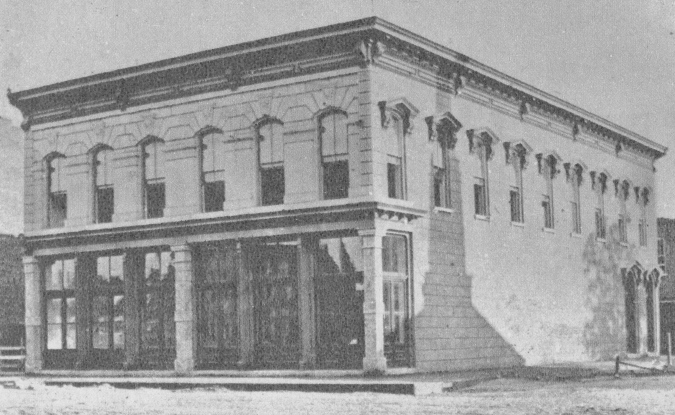 From the first Dallas city government in 1856 to 1872, City Aldermen met in a series of rented quarters. In 1872, a committee was formed to investigate a site for a permanent city hall. The City entered into an agreement with a Mr. Caplin to erect a two-story building at Main and Akard streets, whereby city offices would occupy the second floor. In 1881, Municipal offices moved to Commerce and Lamar streets.
From the first Dallas city government in 1856 to 1872, City Aldermen met in a series of rented quarters. In 1872, a committee was formed to investigate a site for a permanent city hall. The City entered into an agreement with a Mr. Caplin to erect a two-story building at Main and Akard streets, whereby city offices would occupy the second floor. In 1881, Municipal offices moved to Commerce and Lamar streets.
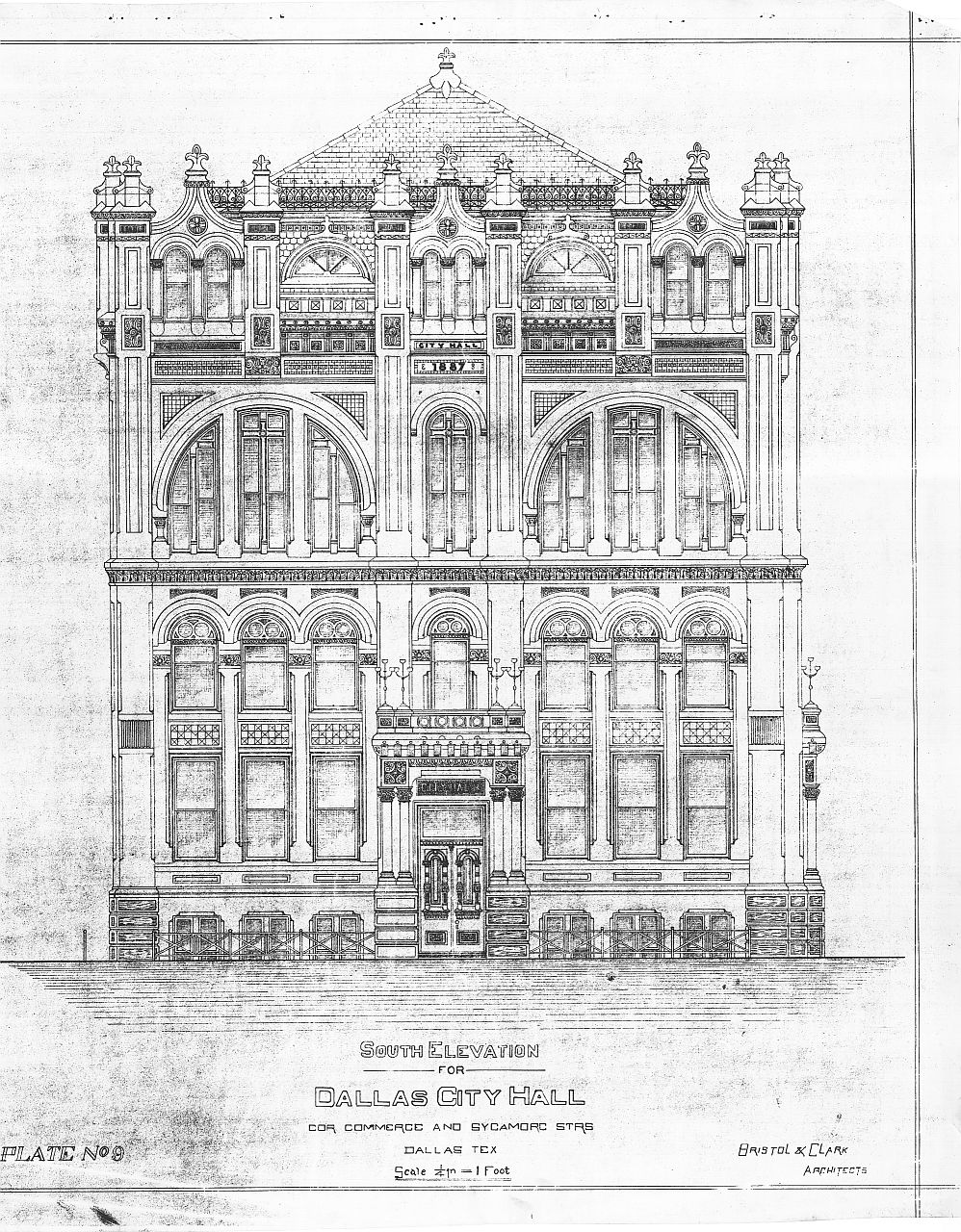 The Renaissance Revival City Hall building occupied the site of the present Adolphus Hotel.
The Renaissance Revival City Hall building occupied the site of the present Adolphus Hotel.
The seat of city government moved once again when, on June 29, 1889, the Commerce and Akard Street location opened. This castle-like Renaissance revival structure of stone served as city hall until an offer too good to pass up was made. On June 22, 1910, the Commerce and Akard land was sold to beer baron Adolphus Busch, who had the old city hall razed and on its site built the luxurious hotel that still bears his name: the Adolphus. During the wait for a new building, temporary quarters were established in a house on Commerce Street between St. Paul and Harwood.
 The Beaux-Arts Style City Hall building known as the Municipal Building.
The Beaux-Arts Style City Hall building known as the Municipal Building.
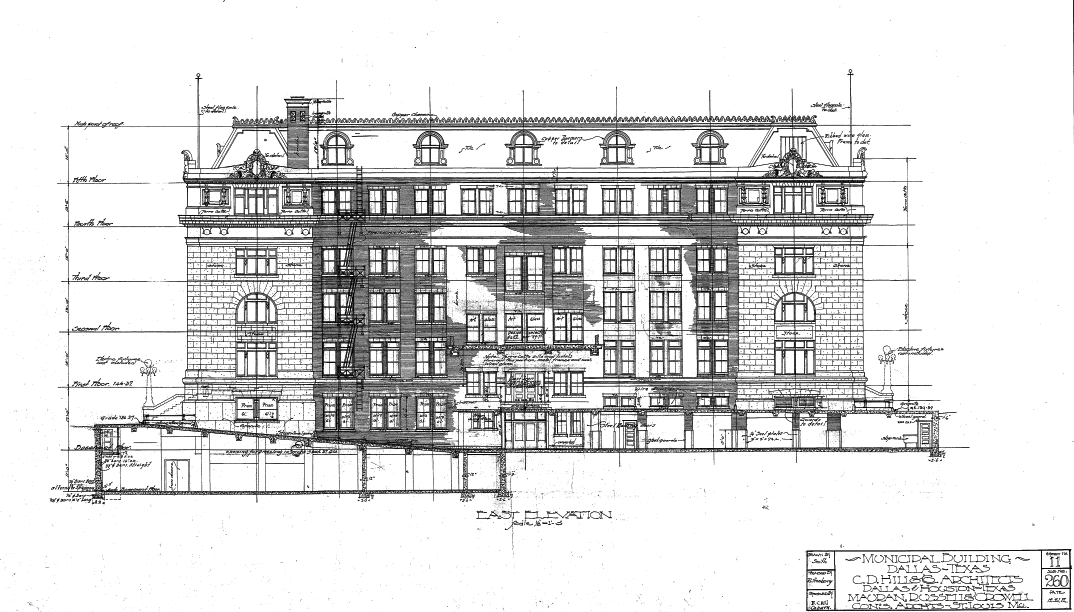 With the Busch money and other funds, the City purchased land in 1911-1912 from Eliza Trice and Otto H. Lang and from the Sweeney Family. Bid specifications and plans were drawn up in 1913, and that spring, Fred A.
Jones Building Company contracted with the city to build the new city hall. Because the building company filed for bankruptcy later that year, the Board of Commissioners passed a resolution to accept the sale and transfer of materials to the receiver, C.C. Street, Jr., and proceeded with the completion of the building. The Municipal Building, designed by C.D. Hill, opened October 17, 1914.
With the Busch money and other funds, the City purchased land in 1911-1912 from Eliza Trice and Otto H. Lang and from the Sweeney Family. Bid specifications and plans were drawn up in 1913, and that spring, Fred A.
Jones Building Company contracted with the city to build the new city hall. Because the building company filed for bankruptcy later that year, the Board of Commissioners passed a resolution to accept the sale and transfer of materials to the receiver, C.C. Street, Jr., and proceeded with the completion of the building. The Municipal Building, designed by C.D. Hill, opened October 17, 1914.
In the basement of this structure on November 24, 1963, Jack Ruby fatally shot Lee Harvey Oswald, alleged assassin of President John F. Kennedy.
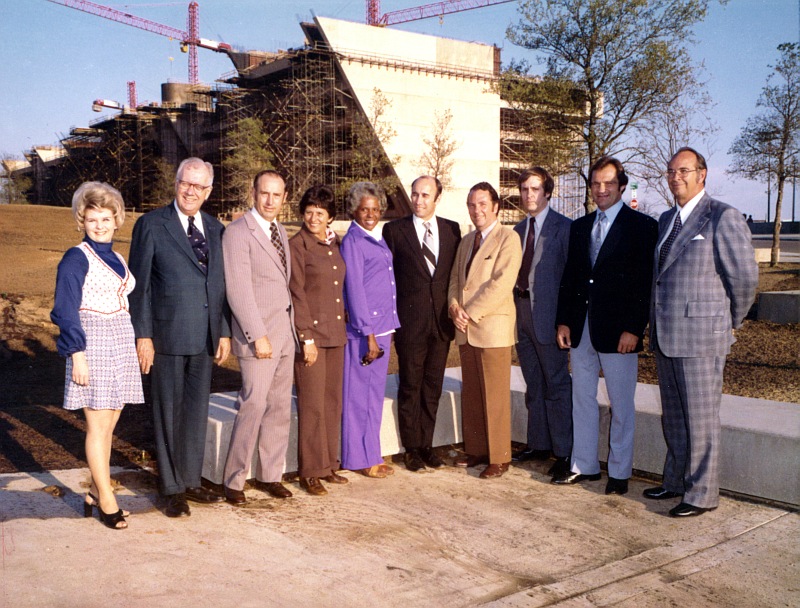 Opened in 1978, the present Dallas City Hall is situated on an 11.8-acre site near the center of downtown Dallas. The overall square footage is approximately one million square feet, including over 374,000 square feet of usable office space, two levels of underground parking for 1426 cars, and public space including the Council Chamber, Flag Room, and Great Court.
Opened in 1978, the present Dallas City Hall is situated on an 11.8-acre site near the center of downtown Dallas. The overall square footage is approximately one million square feet, including over 374,000 square feet of usable office space, two levels of underground parking for 1426 cars, and public space including the Council Chamber, Flag Room, and Great Court.
“It’s time to sing or get away from the piano,” remarked Mayor Wes Wise at the time of Dallas City Hall’s groundbreaking, referring to the long struggle and final commitment to begin the building of the present city hall. Planning for the Dallas Municipal Center, today known as Dallas City Hall, commenced in 1964 when the Dallas City Council appointed a Citizen's City Hall Site Committee to select an appropriate location for new municipal administration offices.
A search committee of prominent citizens settled on I.M. Pei, world-famous designer of the Louvre pyramid addition, the John F. Kennedy Library in Boston, and Dallas’ Morton Meyerson Center. Construction of the new Dallas City Hall commenced on June 26, 1972, under the direction of contractor Robert E. McKee and Pei.
The project was completed in three phases. The City accepted the garage parking areas in November 1974, the Park Plaza in May 1976, and the building in December 1977. The cost of design and construction of the building, the Park Plaza, and the garage was over $70 million. Controversies arose over cost overruns (the original estimated cost was $42.2 million) and aesthetic issues (was the building too avant-garde?); the problems were addressed, and work moved on to completion.
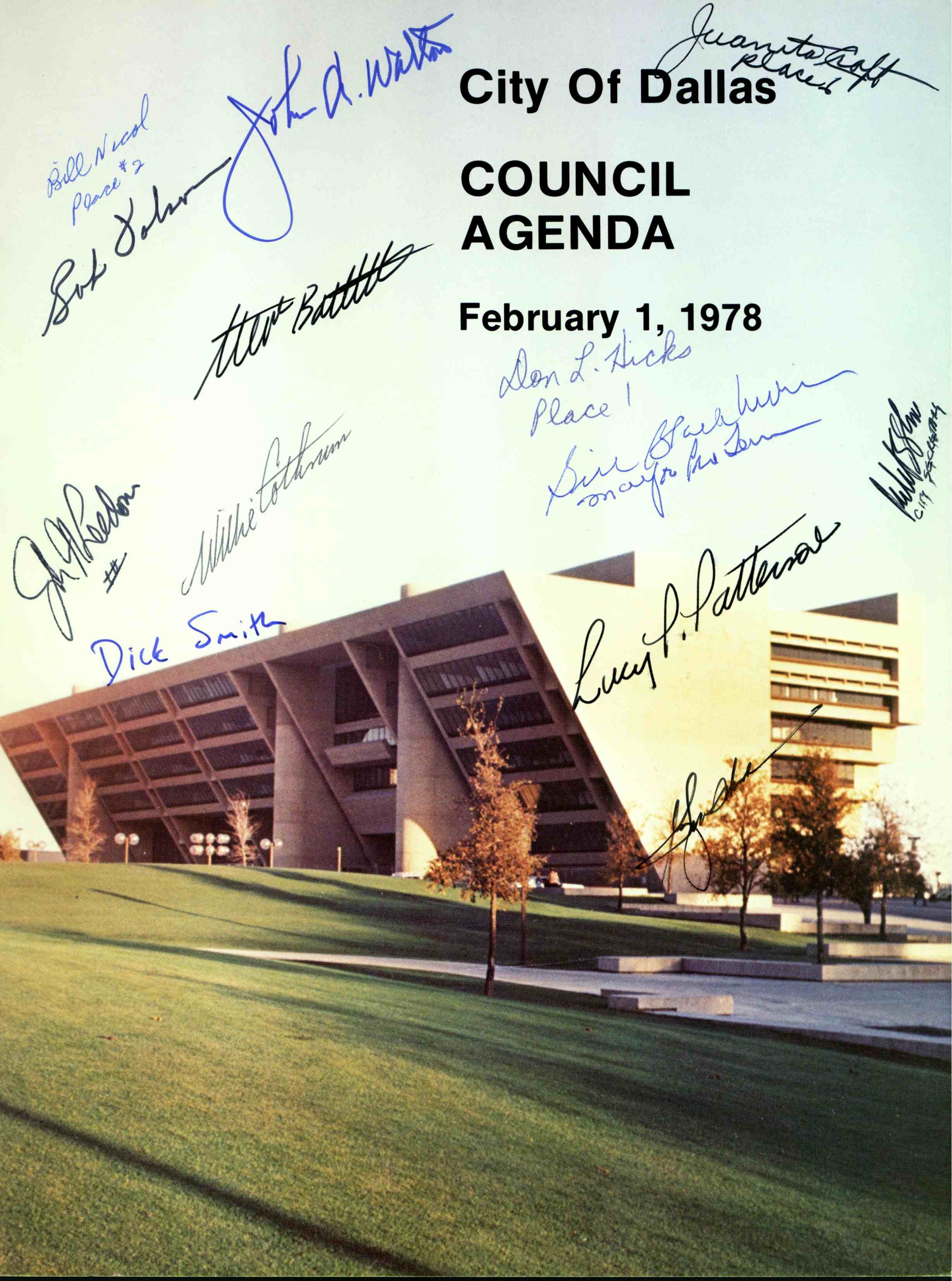 The first Dallas City Council meeting was held in the building's City Council Chamber on February 1, 1978. The City Council Chamber is three stories high with theatre-style seating for 250 persons. The entire facility was formally opened and dedicated on March 12, 1978.
The first Dallas City Council meeting was held in the building's City Council Chamber on February 1, 1978. The City Council Chamber is three stories high with theatre-style seating for 250 persons. The entire facility was formally opened and dedicated on March 12, 1978.
At its opening, City Hall contained 1,400 workstations. It had few floor-to-ceiling walls, using instead five, six, and seven-foot-high partitions to create separate offices. The absence of walls allowed employees and visitors to have window views from all areas. The second floor of Dallas City Hall is referred to as the Great Court because of its 250-foot length and the uninterrupted height of the vaulted ceiling approximately 100 feet above.
The Park Plaza is two blocks long and one block wide and is bounded by Young, Ervay, Marilla, and Akard streets. The Plaza includes a 180-foot diameter reflecting pool, a variable height fountain, park benches, and three distinctive 84-foot high flagpoles. The Plaza is landscaped with live oaks and red oaks—trees native to Texas. The reflective pool, for many years, held large floating sculptures designed by artist Marta Pan.
City Hall Timeline, 1856-1978
| 1856-1872 | City Aldermen met in a series of rented quarters. |
| 1872 | A committee was formed to investigate a permanent city hall. The city entered into an agreement with Mr. Caplin to erect a two-story building at Main and Akard, whereby city offices would occupy the second floor. |
| 1881 | Municipal offices moved to Commerce and Lamar. |
| June 29, 1889 | Commerce and Akard location opened. |
| June 22, 1910 | Commerce and Akard Streets land sold to Adolphus Busch (now the Adolphus Hotel). |
| 1910-1914 | Temporary quarters in a house on Commerce between St. Paul and Harwood Streets. |
| November 6, 1911 | City purchased land from Eliza Trice. |
| November 8, 1911 | City purchased land from Otto H. Lang. |
| December 22, 1911 | Society of Architects met with the Board of Commissioners regarding plans for the new City Hall and City-County Hospital. |
| February 24, 1912 | City purchased land from Sweeney Family for $23,500.00. |
| 1913 | Bid specification and plans drawn. |
| March 1913 | Fred A. Jones Building Company contracts with the city to build the new city hall. |
| November 24, 1913 | Because the building company of Fred A. Jones filed for bankruptcy, the Board of Commissioners passed a resolution to accept the sale and transfer of materials to the receiver, C. C. Street, Jr. and to proceed with the completion of the building. |
| 1914 | Opened for business at 106 S. Harwood, corner of Main, Commerce, Harwood. |
| 1925 | Main Street Annex - purchased from Col. E. H. R. Green (this part partially destroyed when the other annex was built in the 1950s). |
| 1930s | WPA-style murals created by Jerry Bywaters depict the development of the city. (These murals were destroyed in the renovation in the 1950s.) |
| October 1956 | City Hall was renovated and expanded to include an attached new addition at 2014 Main. |
| June 24, 1964 | City Council established a City Hall Committee. |
| February 8, 1965 | The City Hall Committee recommended a new facility and a site at Akard, Canton, Ervay, and Marilla street. |
| June 21, 1965 | City Council established a committee established to appoint an architect. |
| June 27, 1966 | Agreement for Professional Services for Proposed City Hall was reached. I. M. Pei selected to design the building. (File 66-3131A)
|
| May 17, 1972 | Building contract authorized. |
| 1975-1977 | Construction of a New City Hall at 1500 Marilla Street. |
| March 12, 1978 | Dedication Ceremonies for new City Hall at 1500 Marilla were held. City Offices for Dallas Police Department, Dallas Fire Department, and the Municipal Court Services remain housed at the 106 S. Harwood-2014 Main Street Location, while others moved to the new facility. |
Sources:
City Council Minutes and Ordinances (Collection 1994-010)
Dallas City Hall Collection (Collection 1991-124)
Dallas Municipal Building and Fred A. Jones Company Bankruptcy, 1913 (Collection 1991-048)
WPA Dallas Guide and History (Dallas: Dallas Public Library/University of North Texas Press, 1992)
Images courtesy Dallas Municipal Archives